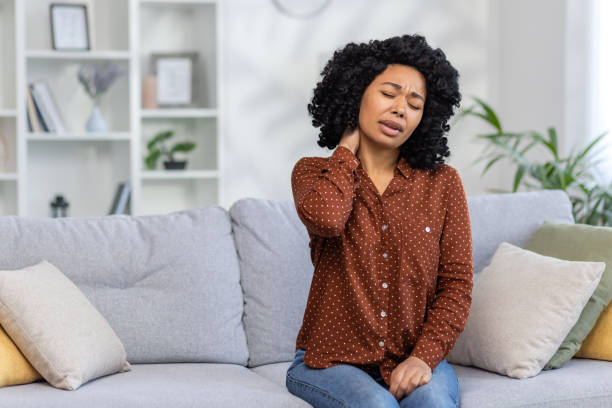By Deborah Bamisaye
“No please, I’m ok. I don’t drink water anything after 8pm so I don’t pee often. You know, I want to have a good sleep because of my BP.”
“Oh, really? That’s ok!”
“One more thing please.”
“What?”
“Can you put off the light, I sleep better that way”
“As how?’ I don’t get! This deem light? Is that how you sleep in your house?”
“Yes, that’s how I sleep in my house o. Light disturbs my sleep and makes me feel it’s not night enough.”
Hmmm! Did you see that? The woman was trying to avoid sleeping in fragments.
Sleep fragmentation is a condition where the normal, continuous pattern of sleep is repeatedly interrupted or broken up by brief awakenings or shifts to lighter sleep stages. This results in fragmented, less restful sleep, preventing the brain from reaching deep, restorative sleep stages. Causes include noise, light, sleep apnea, or other medical conditions. Although total sleep time may not be drastically reduced, sleep fragmentation can lead to excessive daytime sleepiness, impaired cognitive function, memory, and attention, as well as increased health risks such as elevated blood pressure.
Medical Conditions Causing Fragmentation
Medical conditions that causes sleep fragmentation include:
– Obstructive sleep apnea (airway blockages causing repeated awakenings)
– Restless legs syndrome (uncomfortable sensations and urges to move legs)
– Periodic limb movement disorder (involuntary limb jerks during sleep)
– Chronic pain conditions that disrupt sleep continuity
– Gastroesophageal reflux disease (GERD) causing nighttime discomfort and awakenings
– Nocturia (frequent urination during the night)
– Neurological disorders affecting sleep regulation
– Depression and anxiety contributing to disrupted sleep patterns
These conditions cause repeated brief arousals or awakenings, fragmenting normal sleep cycles and reducing restorative sleep quality.
Sleep structure or pattern of your nightly sleep, consist of cycles and stages including non-rapid eye movement (NREM) stages 1, 2, and 3, and rapid eye movement (REM) sleep. These stages follow a specific pattern and rhythm through multiple sleep cycles each night, essential for physical and mental restoration, memory processing, emotional regulation, and overall health.
Age-related Changes in Sleep include:
– Decreased total sleep time and sleep efficiency.
– Increased awakenings and time awake during the night, causing fragmented sleep.
– Reduction in deep slow-wave sleep (stage N3), which is crucial for restorative sleep.
– Decrease in rapid eye movement (REM) sleep.
– Increased lighter sleep stages (N1 and N2).
– Advanced sleep phase causing earlier sleep onset and earlier waking times.
– Decreased sleep spindle activity and K-complexes, which play roles in sleep maintenance and memory consolidation.
– These changes are partly due to alterations in circadian rhythms, homeostatic sleep regulation, and hormone secretion.
– Men tend to experience more pronounced declines in deep and REM sleep with aging compared to women.
– Despite these changes, total sleep architecture tends to stabilize after age 60 in healthy older adults.
Overall, aging leads to lighter more fragmented sleep with reductions in the most restorative phases of sleep.
Corrective Architecture:
Mastering or restructuring sleep architecture means managing sleep cycles and stages better to enhance sleep quality, making it more restorative and healthier. We will be considering how to correct this for older adults and the elderly. Let’s go:
To improve age-related changes in sleep architecture and continuity, older adults can consider the following:
– Increase physical activity: Regular aerobic exercise has been shown to boost restorative deep sleep (slow-wave sleep) and improve overall sleep quality.
– Improve sleep hygiene: Maintain consistent sleep and wake times; create a dark and quiet sleep environment, and avoid stimulants and screen time before bed.
– Light therapy and melatonin: Exposure to bright light during the day and melatonin supplementation can help realign circadian rhythms disrupted by aging.
– Behavioral interventions: Cognitive Behavioral Therapy for Insomnia (CBT-I), sleep restriction therapy, and relaxation techniques promote better sleep consolidation and reduce awakenings.
– Mindfulness and stress reduction: Techniques such as meditation can reduce sleep-related anxiety and improve sleep quality.
– Limit medications: Minimize use of sleep medications unless necessary, as long-term use may impair sleep architecture.
– Consider emerging therapies: Noninvasive brain stimulation and sensory stimulation therapies are being researched for potential benefits in sleep quality for older adults.
These approaches help enhance deep sleep, reduce sleep fragmentation, and improve overall sleep quality, supporting better cognitive function and well-being in aging.
Behavioral Treatments for Elderly Insomnia
Behavioral treatments for elderly insomnia primarily involve Cognitive Behavioral Therapy for Insomnia (CBT-I), which is the first-line, non-drug approach recommended for older adults. Key components include:
– Sleep restriction therapy: Limiting time in bed to consolidate sleep and reduce fragmented periods.
– Stimulus control: Strengthening the bed and bedroom as cues for sleep only, avoiding activities like watching TV in bed and leaving bed if unable to sleep within 20 minutes.
– Sleep hygiene education: Establishing consistent sleep/wake times, avoiding caffeine or heavy meals late in the day, creating a dark, quiet, and cool sleeping environment.
– Relaxation techniques: Progressive muscle relaxation, deep breathing, and meditation to reduce anxiety related to sleep.
– Cognitive therapy: Addressing and changing negative thoughts and worries around sleep.
– Relapse prevention: Ongoing practice and awareness to prevent return of poor sleep habits.
CBT-I has shown effectiveness in helping older adults fall asleep faster, experience less nighttime waking, and improve overall sleep quality, often reducing or eliminating the need for sleep medications.
Customize Your Sleep:
I will conclude by saying “customize it.” Yes o – make yourself comfortable, whatever works for you to have a good sleep – deem light, no light, soft music, little noise, total silence, singing yourself to sleep – anything. Anything that will ensure you enjoy your sleep for each night. Study your sleep pattern and be kind to yourself.
So, beginning from tonight, ensure you – ‘Restructure your sleep and master the architecture?’ Good night!





